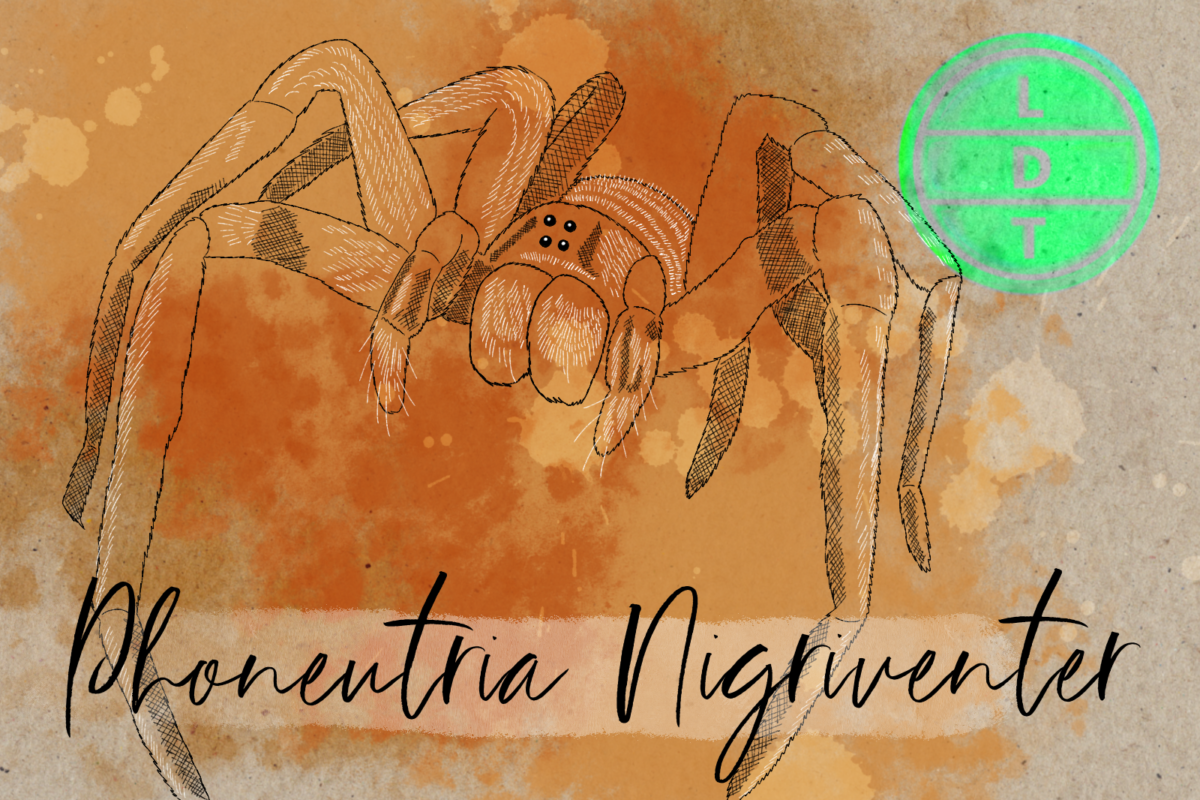“…and today we’re talking about the type of guy who will never settle down, where delicious bugs are, well you know that he’s around. But more on that later.”
When Harry Belafonte tells his fellow banana pickers to hide the deadly black tarantula, he may have been talking about a different spider entirely. The Brazilian Wandering Spider is known for having some of the most powerful venom in all of spider-kind. Plus, it can sometimes be found in banana shipments, so the story checks out. Find out why this eight-legged freak packs such a potent punch here in Life, Death, and Taxonomy.
Description of the Brazilian Wandering Spider
- The Brazilian wandering spider has an almond shaped body with a large abdomen and thorax that’s about a half to two thirds the size.
- Their legs are similar in size and proportion to their body to a tarantula, though maybe a little thinner.
- The spider is brown to tan with black leg segments. Their legs also have thin, black spins pointed down away from their bodies.
- They are covered in dense, fine chitinous hair.
Measure Up
Welcome to the beloved Measure Up segment. The official listener’s favorite part of the show! The part of the show when we present the animal’s size and dimension in relatable terms through a quiz that’s fun for the whole family. It’s also the part of the show that’s introduced by you when you send in audio of yourself saying, singing, or chittering the words Measure Up into ldtaxonomy at gmail dot com. We don’t have a new Measure Up intro!
- Charlotte from Charlotte’s Web
- Miss Spider from James and the Giant Peach
- Black Widow from Corpse Bride
- Rose from A Bug’s Life
Leg Span
- 13 to 18 cm (5.1 to 7.1 in)
- How many spiders go into the height of the largest wave surfed on record by a woman?
- Hint: Brazilian surfer Maya Gabeira broke this record in September of 2020 in Praia do Norte, Portugal. She said, “The wave was pretty special although it was terrifying as well!” The picture looks crazy!
- 124 spider leg spans. The wave was 73.5 foot (22.4 meters).
Weight
- 1 oz (28 g)
- How many Brazilian wandering spiders go into the weight of the number of chicken nuggets that Leah Shutkever was able to eat in one minute?
- Hint: Leah Shutkever is back with a new record this month. You may remember her from our wood frog episode when we talked about her Fererro Rocher eating record. In March 2022, she made records again.
- 12.5 spiders. Shutkever was able to eat 352 grams of nuggets, which is about 19 nuggets.
Fast Fact about the Brazilian Wandering Spider
The Brazilian wandering spider is found in forests in central and South America. They are found as far south as Argentina and as far North as Costa Rica.
Wandering spiders get their name from the fact that they are active predators that hunt for prey, rather than lying in wait in a web.
They hunt on the jungle floor at night and rest in dark hiding places during the day. When humans encounter these guys, it’s often because they find them in laundry baskets, under piles of debris, or most famously in banana containers.
Young spiders spend most of their time in vegetation and take to ground hunting when they reach maturity.
They eat large insects, crickets, lizards, and even small mammals like mice. They are sometimes eaten by insectivorous mammals, including coatis.
Major Fact: Vitriolic Venom
So in the intro to this episode, we mentioned that the Brazilian wandering spider ranks among the deadliest spiders in the world.
The reason is twofold. They have extremely toxic venom. And they inject a lot of it when they bite.
It’s believed that they don’t inject venom with every bite. They may do a “dry bite” in order to conserve venom. Some studies have shown that they may also tailor the amount of venom to the size of their prey.
Because of this behavior, it’s tough to call the Brazilian Wandering Spider the deadliest spider on Earth. The Sydney Funnel Web Spider is often considered the deadliest, even though it may not have the most toxic venom. This is because it doesn’t have the finesse of the wandering spider, it injects as much venom as it can into every bite regardless of the situation. This makes it super dangerous while a bite from a brazilian wandering spider may not even have venom in it at all.
Females produce more venom and so have a greater capacity for deadliness.
If you’re bit, and you get the VIP treatment from the spider, you’ll start to see symptoms in 10 to 20 minutes. Severe pain with shoot throughout the bitten area, your blood pressure will increase, you’ll experience vertigo, feverishness, nausea, vomiting, paralysis, and respiratory depression – making it tough to breathe. This last symptom is usually the fatal one.
Fortunately, there’s an antivenom that will save your life if you’re on the business end of a banana spider’s fang.
However, one symptom, the increased blood pressure, has drawn attention for its uses to treat ED due to the – uh, stiffening effects that the venom has on men.
Ending: So stay on the move, eat your bananas, and keep your venom topped off like the Brazilian Wandering Spider here in LDT.

